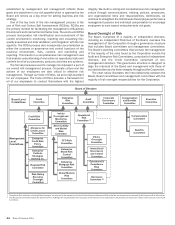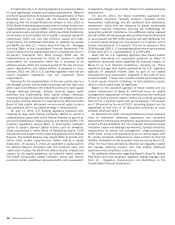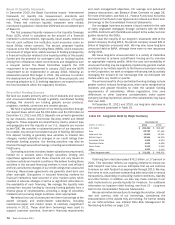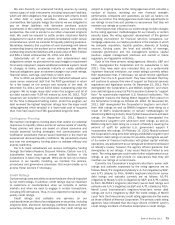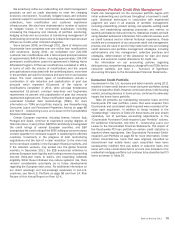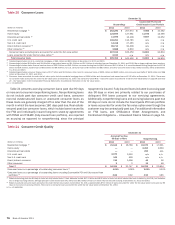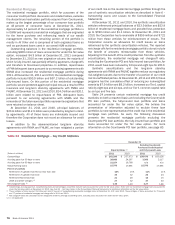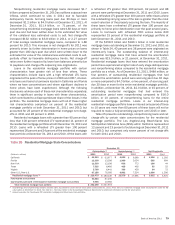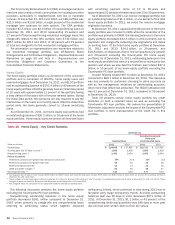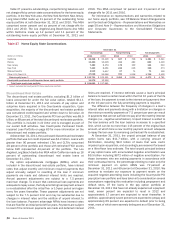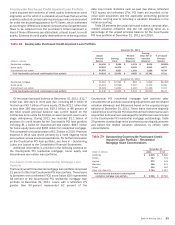Bank of America 2011 Annual Report Download - page 75
Download and view the complete annual report
Please find page 75 of the 2011 Bank of America annual report below. You can navigate through the pages in the report by either clicking on the pages listed below, or by using the keyword search tool below to find specific information within the annual report.Bank of America 2011 73
We also diversify our unsecured funding sources by issuing
various types of debt instruments including structured liabilities,
which are debt obligations that pay investors with returns linked
to other debt or equity securities, indices, currencies or
commodities. We typically hedge the returns we are obligated to
pay on these liabilities with derivative positions and/or
investments in the underlying instruments, so that from a funding
perspective, the cost is similar to our other unsecured long-term
debt. We could be required to settle certain structured liability
obligations for cash or other securities immediately under certain
circumstances, which we consider for liquidity planning purposes.
We believe, however, that a portion of such borrowings will remain
outstanding beyond the earliest put or redemption date. We had
outstanding structured liabilities with a book value of $50.9 billion
and $61.1 billion at December 31, 2011 and 2010.
Substantially all of our senior and subordinated debt
obligations contain no provisions that could trigger a requirement
for an early repayment, require additional collateral support, result
in changes to terms, accelerate maturity or create additional
financial obligations upon an adverse change in our credit ratings,
financial ratios, earnings, cash flows or stock price.
Prior to 2010, we participated in the TLGP, which allowed us to
issue senior unsecured debt that the FDIC guaranteed in return
for a fee based on the amount and maturity of the debt. At
December 31, 2011, we had $23.9 billion outstanding under the
program. We no longer issue debt under this program and all of
our debt issued under TLGP will mature by June 30, 2012. TLGP
issuances are included in the unsecured contractual obligations
for the Time to Required Funding metric. Under this program, our
debt received the highest long-term ratings from the major credit
rating agencies which resulted in a lower total cost of issuance
than if we had issued non-FDIC guaranteed long-term debt.
Contingency Planning
We maintain contingency funding plans that outline our potential
responses to liquidity stress events at various levels of severity.
These policies and plans are based on stress scenarios and
include potential funding strategies and communication and
notification procedures that we would implement in the event we
experienced stressed liquidity conditions. We periodically review
and test the contingency funding plans to validate efficacy and
assess readiness.
Our U.S. bank subsidiaries can access contingency funding
through the Federal Reserve Discount Window. Certain non-U.S.
subsidiaries have access to central bank facilities in the
jurisdictions in which they operate. While we do not rely on these
sources in our liquidity modeling, we maintain the policies,
procedures and governance processes that would enable us to
access these sources if necessary.
Credit Ratings
Our borrowing costs and ability to raise funds are directly impacted
by our credit ratings. In addition, credit ratings may be important
to customers or counterparties when we compete in certain
markets and when we seek to engage in certain transactions,
including OTC derivatives. Thus, it is our objective to maintain high-
quality credit ratings.
Credit ratings and outlooks are opinions on our
creditworthiness and that of our obligations or securities, including
long-term debt, short-term borrowings, preferred stock and other
securities, including asset securitizations. Our credit ratings are
subject to ongoing review by the rating agencies which consider a
number of factors, including our own financial strength,
performance, prospects and operations as well as factors not
under our control. The rating agencies could make adjustments to
our ratings at any time and provide no assurances that they will
maintain our ratings at current levels.
Other factors that influence our credit ratings include changes
to the rating agencies’ methodologies for our industry or certain
security types, the rating agencies’ assessment of the general
operating environment for financial services companies, our
mortgage exposures, our relative positions in the markets in which
we compete, reputation, liquidity position, diversity of funding
sources, funding costs, the level and volatility of earnings,
corporate governance and risk management policies, capital
position, capital management practices and current or future
regulatory and legislative initiatives.
Each of the three primary rating agencies, Moody’s, S&P and
Fitch, downgraded the Corporation and its subsidiaries in late
2011. They have each also indicated that, as a systemically
important financial institution, our credit ratings currently reflect
their expectation that, if necessary, we would receive significant
support from the U.S. government. They have indicated that they
will continue to assess this view of support as financial services
regulations and legislation evolve. On December 15, 2011, Fitch
downgraded the Corporation’s and BANA’s long-term and short-
term debt ratings as a result of Fitch’s decision to lower its “support
floor” for systemically important U.S. financial institutions. This
downgrade resolves the Rating Watch Negative Fitch placed on
the Corporation’s ratings on October 22, 2010. On November 29,
2011, S&P downgraded the Corporation’s long-term and short-
term debt ratings as well as BANA’s long-term debt rating as a
result of S&P’s implementation of revised methodologies for
determining Banking Industry Country Risk Assessments and bank
ratings. On September 21, 2011, Moody’s downgraded the
Corporation’s long-term and short-term debt ratings as well as
BANA’s long-term debt rating as a result of Moody’s lowering the
amount of uplift for potential U.S. government support it
incorporates into ratings. On February 15, 2012, Moody’s placed
the Corporation’s long-term debt ratings and BANA’s long-term and
short-term debt ratings on review for possible downgrade as part
of its review of financial institutions with global capital markets
operations. Any adjustment to our ratings will be determined based
on Moody’s review; however, the agency offered guidance that
downgrades to our ratings, if any, would likely be limited to one
notch. The rating agencies could make further adjustments to our
ratings at any time and provide no assurances that they will
maintain our ratings at current levels.
Currently, the Corporation’s long-term/short-term senior debt
ratings and outlooks expressed by the rating agencies are as
follows: Baa1/P-2 (negative) by Moody’s; A-/A-2 (negative) by S&P;
and A/F1 (stable) by Fitch. BANA’s long-term/short-term senior
debt ratings and outlooks currently are as follows: A2/P-1
(negative) by Moody’s; A/A-1 (negative) by S&P; and A/F1 (stable)
by Fitch. MLPF&S’s long-term/short-term senior debt ratings and
outlooks are A/A-1 (negative) by S&P and A/F1 (stable) by Fitch.
Merrill Lynch International’s long-term/short-term senior debt
ratings are A/A-1 (negative) by S&P. The credit ratings of Merrill
Lynch from the three primary credit rating agencies are the same
as those of Bank of America Corporation. The primary credit rating
agencies have indicated that the major drivers of Merrill Lynch’s
credit ratings are Bank of America Corporation’s credit ratings.



